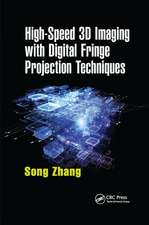Sample Size Calculations for Clustered and Longitudinal Outcomes in Clinical Research: Chapman & Hall/CRC Biostatistics Series
Autor Chul Ahn, Moonseoung Heo, Song Zhangen Limba Engleză Paperback – 30 iun 2020
Sample Size Calculations for Clustered and Longitudinal Outcomes in Clinical Research explains how to determine sample size for studies with correlated outcomes, which are widely implemented in medical, epidemiological, and behavioral studies.
The book focuses on issues specific to the two types of correlated outcomes: longitudinal and clustered. For clustered studies, the authors provide sample size formulas that accommodate variable cluster sizes and within-cluster correlation. For longitudinal studies, they present sample size formulas to account for within-subject correlation among repeated measurements and various missing data patterns. For multiple levels of clustering, the level at which to perform randomization actually becomes a design parameter. The authors show how this can greatly impact trial administration, analysis, and sample size requirement.
Addressing the overarching theme of sample size determination for correlated outcomes, this book provides a useful resource for biostatisticians, clinical investigators, epidemiologists, and social scientists whose research involves trials with correlated outcomes. Each chapter is self-contained so readers can explore topics relevant to their research projects without having to refer to other chapters.
| Toate formatele și edițiile | Preț | Express |
|---|---|---|
| Paperback (1) | 436.14 lei 6-8 săpt. | |
| CRC Press – 30 iun 2020 | 436.14 lei 6-8 săpt. | |
| Hardback (1) | 671.60 lei 6-8 săpt. | |
| CRC Press – 9 dec 2014 | 671.60 lei 6-8 săpt. |
Din seria Chapman & Hall/CRC Biostatistics Series
-
 Preț: 386.63 lei
Preț: 386.63 lei - 5%
 Preț: 338.18 lei
Preț: 338.18 lei - 5%
 Preț: 656.97 lei
Preț: 656.97 lei -
 Preț: 341.43 lei
Preț: 341.43 lei -
 Preț: 355.92 lei
Preț: 355.92 lei - 8%
 Preț: 432.16 lei
Preț: 432.16 lei -
 Preț: 354.78 lei
Preț: 354.78 lei -
 Preț: 342.90 lei
Preț: 342.90 lei -
 Preț: 288.81 lei
Preț: 288.81 lei -
 Preț: 312.36 lei
Preț: 312.36 lei - 9%
 Preț: 644.58 lei
Preț: 644.58 lei - 8%
 Preț: 376.64 lei
Preț: 376.64 lei -
 Preț: 372.30 lei
Preț: 372.30 lei -
 Preț: 356.64 lei
Preț: 356.64 lei - 8%
 Preț: 531.51 lei
Preț: 531.51 lei - 9%
 Preț: 608.33 lei
Preț: 608.33 lei - 9%
 Preț: 766.28 lei
Preț: 766.28 lei -
 Preț: 378.12 lei
Preț: 378.12 lei -
 Preț: 356.64 lei
Preț: 356.64 lei - 9%
 Preț: 682.94 lei
Preț: 682.94 lei - 9%
 Preț: 594.80 lei
Preț: 594.80 lei -
 Preț: 311.47 lei
Preț: 311.47 lei -
 Preț: 362.08 lei
Preț: 362.08 lei - 9%
 Preț: 833.75 lei
Preț: 833.75 lei - 9%
 Preț: 683.12 lei
Preț: 683.12 lei - 9%
 Preț: 681.83 lei
Preț: 681.83 lei -
 Preț: 370.53 lei
Preț: 370.53 lei - 9%
 Preț: 940.39 lei
Preț: 940.39 lei - 18%
 Preț: 791.14 lei
Preț: 791.14 lei - 18%
 Preț: 702.37 lei
Preț: 702.37 lei - 18%
 Preț: 1730.31 lei
Preț: 1730.31 lei - 28%
 Preț: 875.16 lei
Preț: 875.16 lei - 18%
 Preț: 786.89 lei
Preț: 786.89 lei - 25%
 Preț: 825.63 lei
Preț: 825.63 lei - 15%
 Preț: 678.14 lei
Preț: 678.14 lei - 25%
 Preț: 557.58 lei
Preț: 557.58 lei - 29%
 Preț: 625.83 lei
Preț: 625.83 lei - 18%
 Preț: 786.38 lei
Preț: 786.38 lei - 25%
 Preț: 778.07 lei
Preț: 778.07 lei - 25%
 Preț: 628.29 lei
Preț: 628.29 lei - 18%
 Preț: 1124.97 lei
Preț: 1124.97 lei - 28%
 Preț: 881.75 lei
Preț: 881.75 lei - 25%
 Preț: 526.81 lei
Preț: 526.81 lei - 18%
 Preț: 797.46 lei
Preț: 797.46 lei - 15%
 Preț: 479.86 lei
Preț: 479.86 lei - 18%
 Preț: 1017.63 lei
Preț: 1017.63 lei
Preț: 436.14 lei
Nou
Puncte Express: 654
Preț estimativ în valută:
83.48€ • 90.71$ • 70.17£
83.48€ • 90.71$ • 70.17£
Carte tipărită la comandă
Livrare economică 21 aprilie-05 mai
Preluare comenzi: 021 569.72.76
Specificații
ISBN-13: 9780367575991
ISBN-10: 036757599X
Pagini: 260
Dimensiuni: 156 x 234 x 14 mm
Greutate: 0.45 kg
Ediția:1
Editura: CRC Press
Colecția Chapman and Hall/CRC
Seria Chapman & Hall/CRC Biostatistics Series
ISBN-10: 036757599X
Pagini: 260
Dimensiuni: 156 x 234 x 14 mm
Greutate: 0.45 kg
Ediția:1
Editura: CRC Press
Colecția Chapman and Hall/CRC
Seria Chapman & Hall/CRC Biostatistics Series
Cuprins
Sample Size Determination for Independent Outcomes. Sample Size Determination for Clustered Outcomes. Sample Size Determination for Repeated Measurement Outcomes Using Summary Statistics. Sample Size Determination for Correlated Outcome Measurements Using GEE. Sample Size Determination for Correlated Outcomes from Two-Level Randomized Clinical Trials. Sample Size Determination for Correlated Outcomes from Three Level Randomized Clinical Trials.
Notă biografică
Chul Ahn, PhD, is a professor in the Department of Clinical Sciences and the cancer center associate director for biostatistics and bioinformatics in the Simmons Comprehensive Cancer Center at the University of Texas Southwestern Medical Center. He is also director of Biostatistics and Research Design for the NIH-sponsored Clinical and Translational Science Award (CTSA). He has published more than 370 peer-reviewed papers addressing the design and analysis of clinical trials and epidemiological studies as well as the evaluation of repeated measurements and correlated data.
Moonseong Heo, PhD, is a professor in the Department of Epidemiology & Population Health at the Albert Einstein College of Medicine. His research includes sample size determinations for clinical trials, meta-analysis, longitudinal data analysis applying mixed-effects models, handling attrition problems in clinical trials data, and epidemiology in the fields of obesity and psychiatry.
Song Zhang, PhD, is an associate professor in the Department of Clinical Sciences at the University of Texas Southwestern Medical Center. He has extensive experience in the design of clinical trials with correlated outcomes, addressing challenges that involve different correlation structures, missing data patterns, financial constraints, and historical controls. He is also interested in Bayesian statistical methods and their application in longitudinal and survival data analysis, high-throughput data analysis, disease mapping, adaptive design for clinical trials, and missing data imputation.
Moonseong Heo, PhD, is a professor in the Department of Epidemiology & Population Health at the Albert Einstein College of Medicine. His research includes sample size determinations for clinical trials, meta-analysis, longitudinal data analysis applying mixed-effects models, handling attrition problems in clinical trials data, and epidemiology in the fields of obesity and psychiatry.
Song Zhang, PhD, is an associate professor in the Department of Clinical Sciences at the University of Texas Southwestern Medical Center. He has extensive experience in the design of clinical trials with correlated outcomes, addressing challenges that involve different correlation structures, missing data patterns, financial constraints, and historical controls. He is also interested in Bayesian statistical methods and their application in longitudinal and survival data analysis, high-throughput data analysis, disease mapping, adaptive design for clinical trials, and missing data imputation.
Recenzii
"…an excellent resource for both statisticians and practitioners undertaking prospective studies in human trials."
—International Statistical Review
" . . . this is a clearly written and sequentially well-organized book. One may find it easy to read and comprehend the various conceptual and methodological issues. To facilitate better understanding, each of the covered topic deals with illustration. I fully agree with the claim of the authors that this book may serve as a useful resource for biostatisticians, clinical investigators, epidemiologists, and social scientists whose research involves randomized trials with correlated outcomes usually classified into two types: clustered or longitudinal."
—Sada Nand Dwivedi, International Society for Clinical Biostatistics
"The book opens with an excellent summary and overview of conventional sample size analysis, including precision and power analysis. . . The book moves on to sample size calucations for clustered data."
—The American Statistician, 2016
"This book aims to be a useful reference for those of us who are frequently asked ‘how many people will I need to recruit?’ This text provides a useful reference for those who wish to calculate the sample size for a clustered design . . . clear and accessible examples and some thoughtful reminders of key considerations."
—Beth Stuart, International Society for Clinical Biostatistics
"…an excellent resource for both statisticians and practitioners undertaking prospective studies in human trials."
—International Statistical Review
" . . . this is a clearly written and sequentially well-organized book. One may find it easy to read and comprehend the various conceptual and methodological issues. To facilitate better understanding, each of the covered topic deals with illustration. I fully agree with the claim of the authors that this book may serve as a useful resource for biostatisticians, clinical investigators, epidemiologists, and social scientists whose research involves randomized trials with correlated outcomes usually classified into two types: clustered or longitudinal."
—Sada Nand Dwivedi, International Society for Clinical Biostatistics
"The book opens with an excellent summary and overview of conventional sample size analysis, including precision and power analysis. . . The book moves on to sample size calucations for clustered data."
—The American Statistician, 2016
"This book aims to be a useful reference for those of us who are frequently asked ‘how many people will I need to recruit?’ This text provides a useful reference for those who wish to calculate the sample size for a clustered design . . . clear and accessible examples and some thoughtful reminders of key considerations."
—Beth Stuart, International Society for Clinical Biostatistics
"With the huge literature in technical reports, journal articles, blogs, multiple sample size and power packages, and specially written procedures in SAS, R, STATA, MatLab, and other statistical software, one might wonder why we need another book on sample size calculations. The answers will be evident upon reading this text. I write from the point of view of a biostatistician situated in a medical school biostatistics department, scientific reviewer, and consultant. . . . This book offers unified notation, intuitively clear power, and sample size formulas in closed form, and well written explanations in each chapter, making the book easy to use. . ."
—Joel Michalek, Biometrics March 2018
—International Statistical Review
" . . . this is a clearly written and sequentially well-organized book. One may find it easy to read and comprehend the various conceptual and methodological issues. To facilitate better understanding, each of the covered topic deals with illustration. I fully agree with the claim of the authors that this book may serve as a useful resource for biostatisticians, clinical investigators, epidemiologists, and social scientists whose research involves randomized trials with correlated outcomes usually classified into two types: clustered or longitudinal."
—Sada Nand Dwivedi, International Society for Clinical Biostatistics
"The book opens with an excellent summary and overview of conventional sample size analysis, including precision and power analysis. . . The book moves on to sample size calucations for clustered data."
—The American Statistician, 2016
"This book aims to be a useful reference for those of us who are frequently asked ‘how many people will I need to recruit?’ This text provides a useful reference for those who wish to calculate the sample size for a clustered design . . . clear and accessible examples and some thoughtful reminders of key considerations."
—Beth Stuart, International Society for Clinical Biostatistics
"…an excellent resource for both statisticians and practitioners undertaking prospective studies in human trials."
—International Statistical Review
" . . . this is a clearly written and sequentially well-organized book. One may find it easy to read and comprehend the various conceptual and methodological issues. To facilitate better understanding, each of the covered topic deals with illustration. I fully agree with the claim of the authors that this book may serve as a useful resource for biostatisticians, clinical investigators, epidemiologists, and social scientists whose research involves randomized trials with correlated outcomes usually classified into two types: clustered or longitudinal."
—Sada Nand Dwivedi, International Society for Clinical Biostatistics
"The book opens with an excellent summary and overview of conventional sample size analysis, including precision and power analysis. . . The book moves on to sample size calucations for clustered data."
—The American Statistician, 2016
"This book aims to be a useful reference for those of us who are frequently asked ‘how many people will I need to recruit?’ This text provides a useful reference for those who wish to calculate the sample size for a clustered design . . . clear and accessible examples and some thoughtful reminders of key considerations."
—Beth Stuart, International Society for Clinical Biostatistics
"With the huge literature in technical reports, journal articles, blogs, multiple sample size and power packages, and specially written procedures in SAS, R, STATA, MatLab, and other statistical software, one might wonder why we need another book on sample size calculations. The answers will be evident upon reading this text. I write from the point of view of a biostatistician situated in a medical school biostatistics department, scientific reviewer, and consultant. . . . This book offers unified notation, intuitively clear power, and sample size formulas in closed form, and well written explanations in each chapter, making the book easy to use. . ."
—Joel Michalek, Biometrics March 2018
Descriere
This book explains how to determine sample size for studies with correlated outcomes, which are widely implemented in medical, epidemiological, and behavioral studies. For clustered studies, the authors provide sample size formulas that account for variable cluster sizes and within-cluster correlation. For longitudinal studies, they present samp



























